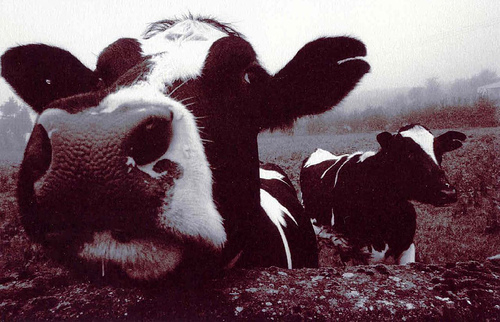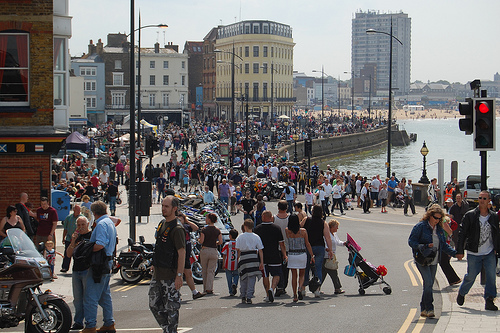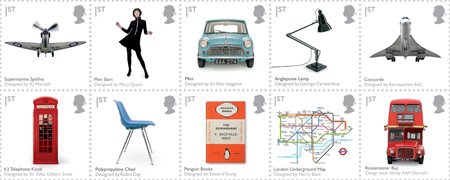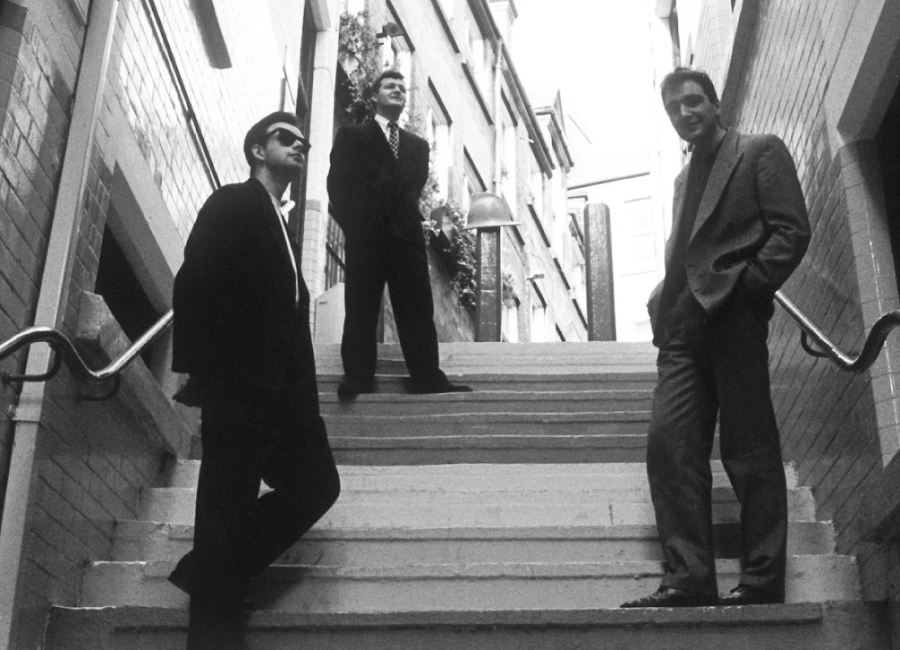A brilliant but rather rude skit by the very talented Cassette Boy on the much loved and hated programme The Apprentice.
Month: May 2009
There’s nothing new in branding.
So what is branding?
Simple question really, but so many people seem to have a misguided opinion on what the answer is.
For us it’s a mark of distinction, it’s a promise of consistent quality, it’s way of speaking and it’s a guarantee that a service or product will be delivered in a way we expect.
But if it’s a mark of distinction, then isn’t this the same as the original term for branding? You know the one – where you put a big stamp on the side of a cow to show you own it and its part of your ‘tribe’ or herd.

Sticking marks on the side of cows was obviously where it started, but now people who wear overtly branded clothes, shoes and hang out in branded retailers are doing the same. They are saying they are part of the same branded ‘tribe’ or herd’ as everyone else with the same brand.
For us, this is a slight problem. Just putting big logos on things is not branding, it’s putting big logos on things. Creating a product that people want to be seen wearing or participating in, so others can see them doing it, is real branding – and its where the future lies.
I was given a ‘corporate gift’ this morning. A business card holder with a huge logo on the side and it is hideous. Not just too big and bulky to work a business card holder but of really nasty quality. How does this reflect on the quality of the client’s inward investment service? What is says to me is that they do things on the cheap, they cut corners and are happy to accept shoddy stuff to hang out with their brand and will only serve to damage their long term future. If you gave 1,000 of them out, no-one who you would want to be seen using it would ever dream of being seen using it. It’s that bad.
If, what you are doing, makes them feel good, then keep doing it. If, as Martin Lindstrom argues in his book Buyology, it causes us to think of interruption, annoyance and the wrong type of herd mentality like the Nokia ringtone that we all hate, then stop immediately.
The future of your brand depends on it.
Thanks to Michelle Lyles for the Cow Photo
Margate, fresh from its appalling rebranding attempts on The Apprentice is most definitely fighting back.
I wrote this article last week and found myself defending the place quite vigorously.
By way of follow up, I have just spoken to a very helpful ‘spokesperson’ at the Tourist information centre and they report that the town was absolutely packed this weekend with thousands of families looking for the type of break that Kate’s team were promoting.
I think there are a few things to learn from this. The first is that the opposite of love isn’t hate. It’s apathy and maybe many of us had got a little apathetic about Margate and British resorts in general. Maybe this programme forced many to look again at their own prejudices and get down there and judge for themselves?
The second and perhaps most important point is that in our own experience of place branding, you need a catastrophic event to start the fight back. There were so many people being negative about the place generally that those of us who have lived there and loved it, stand up and shout back at those who put it down – particularly those who have never even been there.
This has happened in Liverpool, where there is huge civic pride from almost all who have lived there. We saw the same happen in Nottingham when we went through the rebranding process there and maybe the same is starting to happen in Margate.
Margate Old Town is beautiful, the Turner Centre should be spectacular and bring in a whole new audience to visit the shops, cafes and bars of a regenerated town without all the homogenised high street stores we see in every other town and city the world over. If Margate dares to be different, it has a chance to succeed. If it bottles it and homogenises it deserves to fail.
Rebranding any place in isolation will achieve absolutely nothing. Using it as an excuse to show people you have changed and will behave differently going forward has the potential to really work. This applies to ANY brand, be it place, product or service.

Thanks for the shot which is from Blood Oaf on Flickr. See his excellent work here.
There’s a lot to learn from this book, not least of which is the fact that conventional research as a predictor of potential buyer behaviour is on the verge of useless. What we say we will do, buy or watch is barely related to what we do in reality.
But our brain never lies.
Through a series of experiments, involving complicated brain scans, Martin Lindstrom proves that the only way to truly tell what we are most likely do in any given situation is ask a question and watch how our brain reacts.
A few other blindingly brilliant points that come out of this study for me.
The Nokia tune is really irritating and is having a negative effect on the brand, causing a ‘grinding down’ effect that is causing people to feel less comfortable when they hear the well known sound. But this is not the case with many other sonic brands that can cause a more beneficial effect on brand recognition and trigger positive reactions.
Sex doesn’t sell in advertising. Men see the sex and forget the brand, women tend to look at the woman for who she is and if they like them, there may be a positive effect, but more likely they just see the person and again forget the brand.
Branding that really works causes an almost religious like fervour in some of us. If we start thinking about how we can build our brands as religions then we have a better chance of understanding it form the consumers viewpoints. This doesn’t feel that different to Kevin Robert Lovemarks work but the fact that it is backed up with brain scan research, does add a huge degree of validation.
Overall, this is a great book that is pretty easy to follow, incredibly well researched and covers a lot of ground in an interesting way. It feels to be the biggest step forward in understanding buyer behaviours since the 1957 book by Vance Packard called Hidden Persuaders that I remember well for its utterly simplistic view on what causes impulse buying (as I studied this as part of my degree all those years ago)
Another best seller from Martin Lindstrom. Buy It here.
My clever colleague at Purple Circle, Abi Jackson has written a rather nice little blog post about branding in the world of stamps. Have a look at it here.
It’s one of those areas that you maybe don’t notice there is branding even going on, but the Royal Mail have been quietly doing it for years and there have been many beautiful examples ranging from the current UK theme of Plants (Action for Species) right through to Victoria Cross winners back in 2006. All have real design integrity, because you have to work so hard to design something that beautiful in such a small space and still get the salient information across.
In the US now you can even get Simpsons stamps to celebrate their 20 year run. It was selected as a subject from over 50,000 suggested themes. They are officially sanctioned stamps launched by the USPS and they even ran a vote so that people could select their favourite.
Its hard to deny that we all write fewer letters than we used to, but integrating brands into postage stamps could be a lovely way to get kids interested again. If there were Everton FC stamps, my son would find excuses to write to people. 90210 (didn’t this used to be Beverley Hills 90210 – before it got rebranded?) stamps would get my daughters pen up off her desk and into her hand.
Perhaps we should have Bob the Builder ones, that are subsidized by the brand owner to get kids writing, or maybe even the best postage stamps in the world by Carlsberg, or even McStamps by you know who?
Just a thought, but it does seem a good way to raise revenue for the Royal Mail AND engage with new audiences.
Letters, Just do it.

This is my checklist for starting to look at any branding project, in order to capture where the business and the brand already is.
As I’ve said in my work for Purple Circle Branding and on many occasions, branding is not about logos, it’s about a whole raft of ideas that come together to create an overall branded experience. Think of the logo as the marker to know you have arrived at the correct place and you’ll see its context. For me, the brand experience covers every aspect of an interaction or even a potential interaction – so therefore manage it.
In some particular order with the most important first.
1. What are its values and are they published for all to see. More importantly, is there evidence of them actually being lived throughout the organisation?
2. Is the merchandise/product/service supporting the brand experience and actually making it more positive or undermining it by not being as brilliant as it should be?
3. How does the brand speak and look visually? Is it on brand and consistent in every application that’s out there?
4. Has it defined its customers. Can you see from what you are looking at who it is they are expecting to engage with/sell to – and is it who they are actually targeting?
5. How does the website work. Does it look the part, publish the values and really live them?
6. Are the logos being used of a consistent feel. Not necessarily all in the same place and at the same size (as this is just consistent logo usage) but creating the same sort of effect wherever they appear?
7. Are they practicing CRM or MCR (maximising Customer relationships) by engaging with customers in every positive way possible?
8. Is there evidence of customer feedback. Do they use a product such as Feefo to ensure they are constantly engaging with their end users. In effect, are they engaging in dialogue or just giving them diatribe?
9. Are employees engaged and leading at every level. Are they ‘chattering’ externally in a positive way using social media platforms? When you meet or speak to them are they brand advocates, or sales prevention officers?
10. Does the marketing collateral also talk the talk or does it drift towards the desperate in its sales message or continue to reinforce the brand, create the tribe and sell the dream.
11. Is the SEO on track too? A brilliant brand understands writing for SEO and is employing the best techniques throughout the experience.
This is all well and good. There are now only 11 things you need to manage to make a great brand but from this, you need to define three more final things.
1. What are the problems caused by low scores in any of these areas?
2. What does success in any of these areas look like?
3. Conversely, what does failure in any aspect look like?
These are obviously only rough guidelines and there ill need to be a variation for any specific sector but as a brand owner if you manage all of these well, you won’t be far off a great brand.
Here are a few examples of ones I’ve worked on over the years.
In May 1991, three innocent young men started a branding business called Purple Circle at the tender ages of 24 years and with a grand total of 18 months post college work experience. It should have been a recipe for disaster, but somehow, we have kept going and kept growing. Now we’re 18 years old, so we’ve decided to produce a little website to celebrate and we’d love people to contribute so it becomes a showcase for ‘Shed Art’ across the world. Here’s the site and some of the early contributions, but more will be added every day in all sorts of different style and genres. www.shedloadsofideas.com All you need to do is download the template, be creative and then upload your idea to our server for us to showcase your brilliant work to the world. We’ll obviously make any links from your work to your site fully live and reciprocated. Thanks and have fun. John, Mich and Darren Now older and far, far more baldy

Having watched The Apprentice last night for the first time, a few things struck me about the programme itself and the solutions that the contestants put forward as to how they would rebrand Margate.
I am no stranger to city county and place rebrands and was one of the people behind the controversial rebrand of Nottingham and Nottinghamshire, being on the receiving end of tongue lashings from almost every outraged paper in the country for having the nerve to say that there was more to our city and county than just Robin Hood.
I grew up in Margate and had two exceptionally happy years there moving away when I was only six years old. It would be very hard to argue that Margate still lives those glorious days in the 1970’s when Dreamland was at its boom and the new Arlington House flats being built were still hailed as a new way of living for Eastenders moving out from town to a new idyllic life by the sea.

I was in Margate again at the weekend for a few days with my kids, who are ten and twelve, and every single time we go there, we still love the place. Its simple British fun that has had the heart ripped out of it by a dreadful planning decision that put a new ‘out of town’ shopping monster between the main towns of Thanet and destroyed all the others in the process.
But Margate is fighting back. We walked around the old town which has some cool new boutiques and interesting arty stores. It also has some beautiful little shops available for rent for almost nothing. They just need an independent retailer to come in and make a success of it. If you can’t do this with 100SqM of retail space and a rent of £3k per year, you don’t deserve to stay trading anyway. Perhaps subsidised rents would allow the town to be reborn through this growing retail sector.

Margate has a lovely feel to it, if you ignore the slightly tired façade. Offering a family appeal is the perfect answer and so I think Kate and her team were spot on. There was no need to rebrand it as MarGAYte as there is already a thriving gay community there, so what’s the commercial sense in aiming all your marketing money at just one niche. They could have done that easily with some clever PR and a few nicely designed ads.
None of them did actually rebrand the town though.
They just produced campaigns that may drive a few tourists through the door. A rebrand of any town or city only works if you have the whole area behind it. It’s the process of getting to the new logo and the newly agreed strategy that is important a by getting everyone to unite behind a common flag, they agree to talk the place up in the same way and become more able to defend it for what it is and promote it for what it could become.
The designers behind the losing team’s route should be shot for allowing a client to give them such a bad brief. ‘we need a brochure in 20 minutes’ will never work, lying about a reason for white space by the ‘client’ is even worse. Clients invariably get the work they deserve. If you leave a designer 20 minutes to produce a brochure with no distinctive or iconic pictures, too much mediocre copy and someone with no eye for design overseeing it, its always going to be a disaster that should have been prevented.
But the feeling I was left with overall, was why do you need to be that unpleasant in business to win. Surely you can be decent with each other and still succeed by championing what each other does best rather than laying traps into which each can fall and then celebrating when they do?
I was left hating the programme for its nasty snidy attitude.
I was left still loving and defending Margate – for all its faults – and looking at a council team who should be the ones taken out and ridiculed for letting Margate as a seaside town, sell its soul to the retail ‘gods’ who owned the site a few miles up the road.
I can’t imagine I’ll be tuning in again
This is a stunning article from FusionBrand in Malaysia, commenting on the poor year had by Ogilvy and Mather in China and the reaction of their chairman TB Song.
What it says to me is that the future for branding and advertising agencies is a very uncertain one unless they begin to offer measurable ROI on what they do for their clients. This means measurability everywhere.
Rewarding advertising agencies by how much space they buy for you is a dead model. Rewarding them by how much sales revenue they generate will help sharpen their ideas in a massive way, but only if they are allowed to control more of the experience than just the televisual element.
As a design and brand agency it was traditional that we could change logos and create wonderful new design literature, websites, direct mail and all sorts of marketing ‘collateral’ that would win over clients the world over.
But those days are gone. We have to change the core of the businesses now, in order to change the brand.
Brands are born in the customer experience and not in the logo you choose to hang above it. The logo can only ever be a symbol that the customer has arrived in the right place to enjoy their branded experience. Change the logo in isolation and you change nothing. Change the customer experience and mark it with a new logo and you could indeed change the world for that customer.
Unless we have enlightened brand owners who allow designers to enjoy and subsequently manage the ongoing brand experience, one of us will disappear. The old adage ‘if two people in a business always agree, then one of them is unnecessary’ rings truer now than ever before.
Branding as topic that has been fiercely debated and that everyone has an opinion on (right or wrong). Done well, it changes the basis of a business forever. Done badly, it’s a poor old waste of money that brings the industry into disrepute and has been practiced by many since Introducing Monday and Consignia started the trend downwards with the most pointless and superficial logo changes masquerading as rebrands.
So, to all enlightened clients feel free to get in contact and I’ll show you the difference between a new logo, a pointless change and a really brilliant piece of branding that will directly benefit your business and its customers in the long term.
Rather excellent article from Andy Hanselman about why satisfaction is never enough.
Have a read get commenting